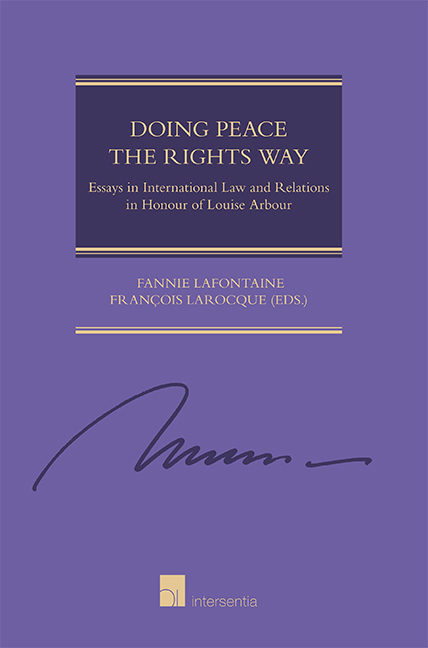Book contents
- Frontmatter
- Foreword
- Contents
- List of Contributors
- Introduction
- PART I OF FREEDOM AND EQUALITY
- PART II OF PEACE AND JUSTICE
- PART III OF WOMEN AND LEADERSHIP
- Leadership in the United Nations and the Challenge of Courage
- The World Bank as a Human Rights-Free Zone
- Come a Long Way and a Long Way to Go: UNSCR 1325 and Women's Participation in Peace-Making
- Why are Women Canada's Fastest-Growing Prison Population and Why Should We Care?
- Moving Beyond Facial Equality: Examining Canadian and French Niqab Bans
- Select Bibliography
- Appendix
- An Interview with the Honourable Madam Justice Louise Arbour
Why are Women Canada's Fastest-Growing Prison Population and Why Should We Care?
from PART III - OF WOMEN AND LEADERSHIP
Published online by Cambridge University Press: 13 April 2019
- Frontmatter
- Foreword
- Contents
- List of Contributors
- Introduction
- PART I OF FREEDOM AND EQUALITY
- PART II OF PEACE AND JUSTICE
- PART III OF WOMEN AND LEADERSHIP
- Leadership in the United Nations and the Challenge of Courage
- The World Bank as a Human Rights-Free Zone
- Come a Long Way and a Long Way to Go: UNSCR 1325 and Women's Participation in Peace-Making
- Why are Women Canada's Fastest-Growing Prison Population and Why Should We Care?
- Moving Beyond Facial Equality: Examining Canadian and French Niqab Bans
- Select Bibliography
- Appendix
- An Interview with the Honourable Madam Justice Louise Arbour
Summary
When I first started work with Elizabeth Fry, I actually believed that there was not much difference between the circumstances of men and women prisoners. It only took a couple of months of being in the job to realize how wrong I was. Women's histories of neglect and abuse, poverty, motherhood, isolation and dislocation, and the overwhelming realization that they really were too often simply considered “too few to count” brought their circumstances into sharp relief, and I soon realized that the landscape of women's criminalization and imprisonment stood in stark contrast to any of my preconceived notions. The women and this work have educated and activated me in many ways, as we have journeyed many bumpy and seemingly obscure paths together.
One such seemingly impassable journey and also one of life's turning points for me started on 28 April 1994, the day that I went into the Prison for Women (P4W) in Kingston aft er the emergency response team had stripped and shackled several women and left them naked or dressed with only a flimsy paper “gown” in the segregation unit. At the end of that long day, when I advocated that they unshackle the one woman who was still restrained and release from segregation all eight of the other women, I was advised that I was misinformed about the circumstances and treatment of the women and that, in fact, there were no women in restraints. When I insisted that I had actually observed the shackles, it was suggested by staff that perhaps it was a reflection from the bars. And when I persisted, I was counselled against being so easily “conned” by the women.
As I exited P4W that evening with my then three-and-a-half-year-old son, I remember standing on the steps and realizing that they must believe that this information would never emerge and that if it did, no one would ever believe it. On that day, I thought, I don‘t know exactly how to do this, I don ‘ t know how one comes up against a system that has all of the resources and a full government department of lawyers to assist them in that process, but I had better figure out how.
- Type
- Chapter
- Information
- Doing Peace the Rights WayEssays in International Law and Relations in Honour of Louise Arbour, pp. 423 - 442Publisher: IntersentiaPrint publication year: 2019



